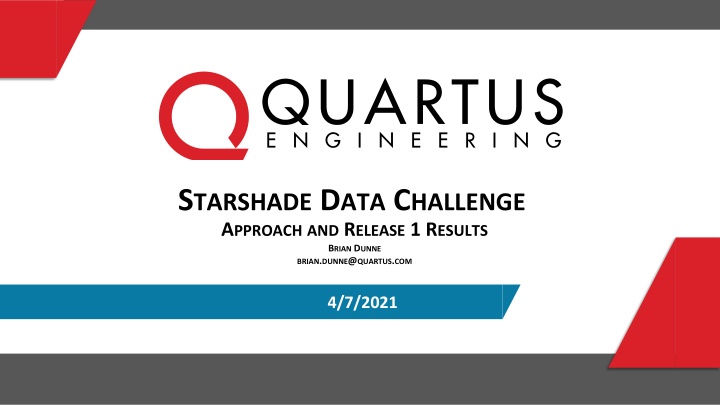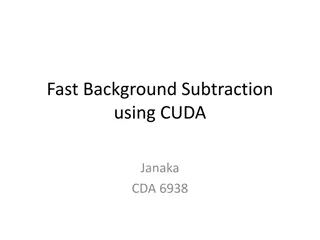STARSHADE DATA CHALLENGE Approach & Release: Proposed Methods for Background Estimation
The proposed approach for the STARSHADE DATA CHALLENGE involves three high-level steps focusing on background estimation and removal, transformation of multi-spectral foreground image pixels, and Bayesian inference for planet detection. Findings from background estimation development may lead to revised ideas for later steps. Prioritizing exozodiacal disks for background estimation, a parametric model is constructed initially through an empirical approach. A detailed parametric model for exozodiacal disk image is developed, including parameters for center position, inclination, orientation, and intensity roll-off function.
Download Presentation

Please find below an Image/Link to download the presentation.
The content on the website is provided AS IS for your information and personal use only. It may not be sold, licensed, or shared on other websites without obtaining consent from the author.If you encounter any issues during the download, it is possible that the publisher has removed the file from their server.
You are allowed to download the files provided on this website for personal or commercial use, subject to the condition that they are used lawfully. All files are the property of their respective owners.
The content on the website is provided AS IS for your information and personal use only. It may not be sold, licensed, or shared on other websites without obtaining consent from the author.
E N D
Presentation Transcript
STARSHADE DATA CHALLENGE APPROACH AND RELEASE 1 RESULTS BRIAN DUNNE BRIAN.DUNNE@QUARTUS.COM 4/7/2021
PROPOSED APPROACH The proposed approach includes three high level steps: 1. Background estimation and removal. 2. Transformation of the multi-spectral foreground image pixels into a feature space based on matched filtering. 3. Perform Bayesian inference on the feature space to produce a likelihood ratio which can be thresholded for planet detection. The initial focus is on background estimation and removal, since backgrounds must be successfully estimated and removed before later steps in the pipeline can be used. Initial findings during the background estimation development may also lead to revised ideas for the later steps. 2 Quartus Engineering Incorporated
RELEASE 1 DATA OBSERVATIONS A visualization of all the SNR3 cases is shown for reference. All exozodiacal disks appear to be symmetric with a smooth intensity roll-off. This was also stated in the data release notes. The most notable variability comes from: Relative intensity of the disk Inclination and orientation Decenters between exozodiacal disk, starshade center, and image center. 3 Quartus Engineering Incorporated
BACKGROUND ESTIMATION APPROACH The first step in the process is to estimate backgrounds in the release 1 data. After visualizing the data it seems clear that exozodiacal disks are the strongest background source and should be prioritized for estimation and removal. Because the disks seem smooth and radially symmetric within an orbital plane, a parametric model seems appropriate. Two general approaches can be taken towards constructing a parametric model: First principals approach: In this approach a parametric model would be constructed according to theory which describes the structure of a disk and how it scatters light. For example the mass distribution may be described by a hydrostatic equilibrium, with some model of how light is scattered by the dust and rolls off with distance from the star. It seems like a lot of prior research exists on this topic. Empirical approach: In this approach a parametric model would be constructed simply to match the image data as it appears, independently of physical theory. For example the disks appear to have a certain radial symmetry in a given plane, and have 1D function which describes the intensity vs radial distance from the center. The empirical approach is taken initially, i.e. a parametric model is constructed simply through inspection of the data and iterating on quality of fit via a guess and check process. 4 Quartus Engineering Incorporated
EXOZODIACAL DISK PARAMETRIC MODEL Based on visualizing the data and the description in the release notes, a parametric model for an exozodiacal disk image was developed with the following parameters: Center position ??,??(pixels) Inclination and Orientation ?,? (deg) 1D function for symmetric intensity roll-off: ? ? = ??(??2+??+?), where: r is radial distance from the center ? is an intensity scale factor a,b, and c are polynomial coefficients This gives a total of 8 parameters, denoted by parameter vector ?: ? = [ ??,??,?,?,?,?,?,?] 5 Quartus Engineering Incorporated
EXOZODIACAL DISK PARAMETRIC MODEL Fitting the parametric model to observed data is performed as a nonlinear regression. The goal is to minimize a cost function which represents the error between the observed image and the image predicted by the parametric model. The optimization problem to be solved is defined as: ? = arg?min ?(I ,?(?)) ? ? I ,? ? = ?(? ?? ??)?? ?=1 Where: ? represents the free parameter vector ? represents the cost function ? is the parameter vector estimate resulting from minimizing the cost function ??represents a per-pixel weighting ? is a modified Huber Loss function The optimization is currently being performed using the Levenberg Marquardt algorithm. The regression approach is being implemented in a modular fashion such that loss function, weighting scheme, and optimization algorithm can be easily mixed and matched as the complexity of the regression problem grows. 6 Quartus Engineering Incorporated
BACKGROUND ESTIMATION APPROACH Solving the regression problem requires some consideration of handling unmodeled effects. Since the current approach only attempts to model the exozodiacal disk, the regression may perform poorly to the presence of unmodeled effects. The three most significant unmodeled effects in the images appear to be: 1. Occulter transmission, star flux, or any other fast-decaying effects near the starshade center. 2. A baseline background intensity level.(i.e. dark noise) 3. Exoplanets. Regarding 1. Occulter transmission and other fast-decaying effects which are significant near the starshade center, but decay quickly with radial distance: An initial attempt was made to add those effects to the parametric model, but results were not so great. The quick and easy solution was to use the weighting scheme in the regression to set pixel weights to zero in a region around the starshade center. This is shown in the results as a masked region in the image. Regarding 2. Simply subtracting the median intensity from the image gave decent results and allowed the parametric model of the disk intensity to roll off to zero. Regarding 3. The chosen loss function, which is a modified Huber loss function, can be tuned to handle the exoplanets as outliers. The regression method attempts to be robust against outliers, and therefore does not consider the planets heavily in the cost. This can be improved further with a two-pass regression where pixels with large errors in the first pass are rejected as outliers and the regression is solved again excluding those pixels. 7 Quartus Engineering Incorporated
INITIAL RESULTS Rather than showing results for all 30 cases, a few examples are shown that are categorized as: good, mixed, or bad. Good results are categorized by a residual which is dominated by noise and/or exoplanets. I.e. the model has successfully accounted for a large majority of the image content attributable to the disk. Mixed results are categorized by a residual where background is highly attenuated, but the residual has some significant structure or bias that is an artifact of the background subtraction. Bad results are categorized by a residual which still contains significant disk structures with intensity that is dominant over exoplanet signals. 8 Quartus Engineering Incorporated
GOOD RESULTS 9 Quartus Engineering Incorporated
GOOD RESULTS 10 Quartus Engineering Incorporated
GOOD RESULTS 11 Quartus Engineering Incorporated
MIXED RESULTS 12 Quartus Engineering Incorporated
MIXED RESULTS 13 Quartus Engineering Incorporated
MIXED RESULTS 14 Quartus Engineering Incorporated
BAD RESULT 15 Quartus Engineering Incorporated
NEXT STEPS Investigate variability in results across the scenarios for the current approach. Unmodeled effects. It seems likely that a big part of the residuals in the Mixed Results examples are attributable to unmodeled effects near the center of the starshade which do not roll off quickly enough to be neglected. This could include occulter transmission, star effects, or solar glint. These effects may exist even in the good cases with the main difference being relative exoplanet intensity. These case could be handled better either with additional model parameters or an adjusted loss/weighting scheme. Optimization failures. It seems like at least in the Bad result scenario the optimizer failed to find the global minimum. It s not totally obvious that the regression problem is convex or well conditioned, or if it is whether it will remain so as more parameters are added to the models. Estimate more of the target parameters Exozodiacal disk parameters are being estimated in some sense, but they need to be converted to physical units. Isolated exoplanets are clearly visible in the residuals, but additional work needs to be done to detect them and estimate their parameters.(i.e. using a matched filtering approach.) Investigate benefits of multispectral data when it is available Multispectral images will likely give big advantages for separating components of the image and estimating parameters. For example various components will have different spectral characteristics which will provide big advantages for separating background and foreground components. 16 Quartus Engineering Incorporated
REFERENCES AND RELEVANT LINKS References Rafels, S. H., Shaklan, S. B., Turnbull, M. C., & Cady, E. J. (2019). SISTER: Starshade Imaging Simulation Toolkit for Exoplanet Reconnaissance (Conference Presentation). Techniques and Instrumentation for Detection of Exoplanets IX. doi:10.1117/12.2528332 Hastie, T., Friedman, J., & Tisbshirani, R. (2017). The Elements of statistical learning: Data mining, inference, and prediction. New York, New York: Springer Vio, R., Andreani, P., & Wamsteker, W. (2004). Some good reasons to use matched filters for the detection of point sources in CMB maps. Astronomy & Astrophysics, 414(1), 17-21. doi:10.1051/0004-6361:20031632 Relevant Links http://sister.caltech.edu/ https://asd.gsfc.nasa.gov/Christopher.Stark/catalog.php https://en.wikipedia.org/wiki/Robust_statistics https://www.mathworks.com/matlabcentral/fileexchange/39564-lmfnlsq2 17 Quartus Engineering Incorporated























